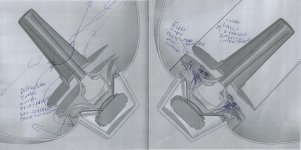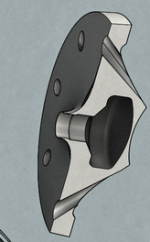
Art,
Sketch goal here, to use a larger diameter LF driver in parallel and employ the compression plug as in the Graber design.
The L transition maintains a steady volume around the 90-degree turn (estimated on the horn volume at that section, the goal of not compressing the volume around the turn.)
Horn compression driver size is estimated, the red bass driver is drafted at 8" diameter. The orange compression plug sends the LF out next the HF into the parabolic dish.
Dark blue surfaces denote the donor megaphone.
Stratotron,The L transition maintains a steady volume around the 90-degree turn (estimated on the horn volume at that section, the goal of not compressing the volume around the turn.)
Nice looking pictures!
The radial ring’s “mouth” should extend to the lower portion of the hyperbola and it’s terminus to prevent diffracted sound waves combining destructively (“comb filtering”) within the horn.
Parabolas and hyperbolas are both open curves. In the case of a parabola, the two arms eventually become parallel to each other, whereas in the case of a hyperbola, they don’t.
The hyperbolic curve is preferable for sound projection, as the area of the mouth must expand to be large enough to prevent diffraction of wavelengths longer than the exit diameter “spilling” out with no directivity control.
You have left out an element of the compression (phase) plug design, channels providing for equalizing the distance traveled from the inner radial inlets to perimeter outlet exits.
In your two-way design, that feature is less important, as the LF driver will only need to reach to 500-1000 Hz.
Output through the ports in that frequency range will be well under 1/4 wavelength of each other and sum constructively from a cone with only an 8” diameter.
Rather than exiting through a separate “ring”, the ports could be placed in the HF horn’s radial ring.
Minimizing the volume of the throat chamber (the volume of air between the cone and filler plug) is important, as the volume increases, the acoustic band pass it creates goes down in frequency. The distance between the filler plug and cone should be greater than the driver’s Xlim (usually around double Xmax) to prevent contact at high excursions.
The shorter path length from the LF in relation to the HF driver will probably require it’s output delayed to time align and sum constructively. It is possible to sum constructively using a passive crossover if the phase response is in alignment at the acoustic crossover point, though the LF still will lead the HF by one (or more) wavelengths.
Art
Attachments
Parabolas and hyperbolas are both open curves. In the case of a parabola, the two arms eventually become parallel to each other, whereas in the case of a hyperbola, they don’t.
The hyperbolic curve is preferable for sound projection, as the area of the mouth must expand to be large enough to prevent diffraction of wavelengths longer than the exit diameter “spilling” out with no directivity control.
Art, thanks for taking the time to sketch over the drawing, super informative and much appreciated!
I've incorporated the concepts into a new sketch. One alteration is the width of the L channel. For focus I'd like it to have as narrow as possible an exit, without constricting the flow. To get there, I have drawn the centerline of the horn walls and measured the cross-section area perpendicular to that line. As the diameter increases, the width decreases so that the net cross-sectional area is slightly increasing out to the edge.
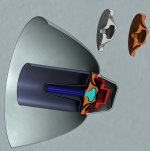
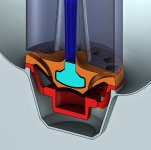
I've drafted based on a B&C 10NW64 10" Neodymium Woofer, the compression plug can use the extra space to get around the HF driver. Since this is meant to be portable, weight savings is important.
Concerning parabola vs hyperbola. I am drafting with a program called Rhino3D. It has tool for generating both types of curves. The focus point drives both of the curves. In the images there is a white dot at the center of the mouth of the exit ring. This is focus point of both the parabola and the hyperbola blue line. I matched the width ends for this test. I have done other test but they all have the same result.
I chose four points along each curve. Drew a line perpendicular. Drew a line back to the focus/exit point. Reflected/mirrored that line about the perpendicular. Extended those lines out a distance and cut them all off at an arbitrary even length. The parabola lines are parallel and equal in length, indicating a plane wave. The hyperbolas all have lines that spread slightly and are not the same length when they reach a given distance. I am depending on the math of the CAD program to generate the curves, it is a program that takes its curves seriously so I trust it.
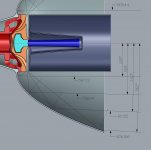
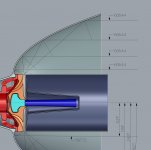
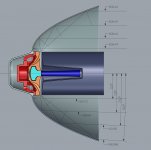
I've drafted the compression plug with the appropriate spacing, one with your recommendation of eight holes, and one with more channel volume and directing curvature. I do not understand these at all, so just going by gut feel.
Thanks again for the feedback.
The straight hole port arrangement would work better than the complicated one that will mess up the HF horn's response 😉
The profile width/depth looks similar to my Hyperboline, which did well down to 200 Hz as far as pattern control.
The profile width/depth looks similar to my Hyperboline, which did well down to 200 Hz as far as pattern control.
Attachments
Last edited:
I’m reviving this thread as I’m researching directional speakers for a sound installation and found a lot of helpful posts here.
The installation will be set in a forest and will play whispering voices recorded with binaural techniques. I want it to create a mystical feeling, like someone is whispering in your ear but you don’t see that person.
I first looked into ultrasonic directional speakers mentioned earlier in this thread, but I wasn’t thrilled about their limitations. After reading this thread and similar projects, I’m convinced a parabolic/hyperbolic reflector is the way to go. I’m hoping it will feel like the speakers are closer than they really are, so especially during night it will be a surreal experience when you don’t see the speakers properly.
I’m slowly figuring out how to make these devices in a not-too-complicated DIY way.
First I thought about using a single compression, like Sb Audience ROSSO-75CDN-T, which seems like great value for money and can go quite low. I could 3d print a larger rear chamber like this one to lower the fs even more. Because it’s a sound installation playing whispers the low frequencies are not important (I guess that would also mean a gigantic reflector dish).
Although the reentrant horn idea looks great, I think this is going to be easier for me to construct a horn that points directly at the reflector dish like the Myers SB-1. See a rough sketch below

After making this sketch I started wondering if using a multiple entry horn would be a better idea. Because the horn would be circular I thought I could use a bucket as an enclosure and 3D print a horn that fits perfectly in the bucket.

The idea developed further. I thought about aiming the horn into the dish from an angle so that it’s not in the way of the beam.

Here is a horn using the R-OSSE formula in ATH 4. It has 2 elongated mid ports.

I also started looking into methods of how to make the reflector dish. It looks like the diy solar people have some great techniques. Here are two videos - video 1 - video 2.
Art mentioned that he had the best experience with a hyperbola, and I guess I get more of a parabolic shape using the vacuum or bike pump methods shown in the videos. So I started thinking of a different way to do it.
Right now I’m thinking of building a big circle with a stretchy material wrapped around it. Mylar, the kind used in solar ovens, seems like a good option, but I don’t need the reflective surface. If anyone has a better idea for material, I’d love to hear it.
Then I’d need a template for the hyperbolic dish. I could 3D print the whole inner surface, but that feels like a waste of filament and time. Since a hyperbolic dish has straighter outer walls than a parabolic one, I figured I might get away with just printing the middle part in a kind of mushroom shape. The mushroom would sit in the center and the Mylar would be stretched around it. After that, I’d add fiberglass and resin to hold the shape.
Here is a sketch of the mylar being stretched over the mushroom template. This is a hyperbolic dish that's ca 1.4m i diameter.

What do you guys think, are there any easier or better methods to construct this?
And my big question. Will it have the effect I'm hoping for, a sense of someone whispering in your ear?
The installation will be set in a forest and will play whispering voices recorded with binaural techniques. I want it to create a mystical feeling, like someone is whispering in your ear but you don’t see that person.
I first looked into ultrasonic directional speakers mentioned earlier in this thread, but I wasn’t thrilled about their limitations. After reading this thread and similar projects, I’m convinced a parabolic/hyperbolic reflector is the way to go. I’m hoping it will feel like the speakers are closer than they really are, so especially during night it will be a surreal experience when you don’t see the speakers properly.
I’m slowly figuring out how to make these devices in a not-too-complicated DIY way.
First I thought about using a single compression, like Sb Audience ROSSO-75CDN-T, which seems like great value for money and can go quite low. I could 3d print a larger rear chamber like this one to lower the fs even more. Because it’s a sound installation playing whispers the low frequencies are not important (I guess that would also mean a gigantic reflector dish).
Although the reentrant horn idea looks great, I think this is going to be easier for me to construct a horn that points directly at the reflector dish like the Myers SB-1. See a rough sketch below
After making this sketch I started wondering if using a multiple entry horn would be a better idea. Because the horn would be circular I thought I could use a bucket as an enclosure and 3D print a horn that fits perfectly in the bucket.
The idea developed further. I thought about aiming the horn into the dish from an angle so that it’s not in the way of the beam.
Here is a horn using the R-OSSE formula in ATH 4. It has 2 elongated mid ports.
I also started looking into methods of how to make the reflector dish. It looks like the diy solar people have some great techniques. Here are two videos - video 1 - video 2.
Art mentioned that he had the best experience with a hyperbola, and I guess I get more of a parabolic shape using the vacuum or bike pump methods shown in the videos. So I started thinking of a different way to do it.
Right now I’m thinking of building a big circle with a stretchy material wrapped around it. Mylar, the kind used in solar ovens, seems like a good option, but I don’t need the reflective surface. If anyone has a better idea for material, I’d love to hear it.
Then I’d need a template for the hyperbolic dish. I could 3D print the whole inner surface, but that feels like a waste of filament and time. Since a hyperbolic dish has straighter outer walls than a parabolic one, I figured I might get away with just printing the middle part in a kind of mushroom shape. The mushroom would sit in the center and the Mylar would be stretched around it. After that, I’d add fiberglass and resin to hold the shape.
Here is a sketch of the mylar being stretched over the mushroom template. This is a hyperbolic dish that's ca 1.4m i diameter.
What do you guys think, are there any easier or better methods to construct this?
And my big question. Will it have the effect I'm hoping for, a sense of someone whispering in your ear?
The phase and directional information created by microphones in the ear's pinna when reduced to mono simply sounds "low fidelity", peaks and dips in frequency response and off axis phase cancellations.The installation will be set in a forest and will play whispering voices recorded with binaural techniques. I want it to create a mystical feeling, like someone is whispering in your ear but you don’t see that person.
The trees in a forest will block and disperse high frequency sound.
And the low frequencies "spill out" of even a gigantic parabolic dish.Because it’s a sound installation playing whispers the low frequencies are not important (I guess that would also mean a gigantic reflector dish).
Meyers dishes used a phase and frequency manipulated 12" speaker in the center to cancel much of the 500Hz range off axis spill.
That would require an asymmetrical dish and horn, both difficult to design and construct, and would still not direct lower frequencies, which are not needed for whispers.I thought about aiming the horn into the dish from an angle so that it’s not in the way of the beam.
Does not look hyperbolic, and far too shallow. The designs in posts #60, 62 and 63 should give you an idea of the depth required.Here is a sketch of the mylar being stretched over the mushroom template. This is a hyperbolic dish that's ca 1.4m i diameter.
If the recording (or live presentation) is good, bandwidth limited, and the ears are located within the narrow beamwidth, and the parabolic or hyperbolic beam is not reflected by or obstructed by trees in the forest, yes.And my big question. Will it have the effect I'm hoping for, a sense of someone whispering in your ear?
Also understand the planar wave from the parabolic or hyperbolic beam ideally is non-divergent, it's output is only the diameter of the wave guide.
Depending on the coverage area and distance, a simple long narrow conical horn may do what you want better than a hyperbolic or parabolic reflector, and be far easier to construct.
Also understand that air absorption (and diffraction) of very high frequencies limits the effective distance they carry, even if the theoretical drop per doubling of distance is reduced from -6dB to -3dB.
https://sengpielaudio.com/calculator-air.htm
Whispers sound like whispers primarily because they have more high frequency content than normal speech, so the further from the source, the more they will sound like whispering through a pillow.
At 100 meters, the HF content may sound less than half as loud relative to the lower frequency content.
Art
I didn't think of a parabolic reflector, that would be a fairly easy build as well.
That may be the first thing to try. I don't have time for trial and error, but that seems highly likely to work right the first time versus lots of tweaking.
Hi from Diyma
Two parabolic reflectors is what you want
Google "listening vessel"
There's one in Houston and one in Seattle, I've tried both
It should be possible to do it with a pair of satellite dishes
Plenty of people on Craigslist give em away, especially since DirecTV is dying
You could probably run a small business dedicated to just removing those eyesores off of people's houses
Thanks for valuable input Art. I will develop the idea a bit further, but it I like the thought of just using a long narrow conical horn instead.Depending on the coverage area and distance, a simple long narrow conical horn may do what you want better than a hyperbolic or parabolic reflector, and be far easier to construct.
Focused4door wanted a loudspeaker to direct a narrow beam of speech range sound 450 feet in one direction for a Halloween prank 5 years ago.Two parabolic reflectors is what you want
The DirecTV dish I removed from my roof is too small and shallow to be useful as a parabolic sound reflector.It should be possible to do it with a pair of satellite dishes
Plenty of people on Craigslist give em away, especially since DirecTV is dying
I just read post 65, and what you're trying to do won't work.
These things can't do high frequencies, so don't even bother with a two-way.
Just use an efficient midbass that can play high.
At 10khz, a pathlength difference of ONE CENTIMETER will screw up your highs.
There's absolutely no way you can get the pathlengths perfect (unless you put the audiences head in a vise.)
These things can't do high frequencies, so don't even bother with a two-way.
Just use an efficient midbass that can play high.
At 10khz, a pathlength difference of ONE CENTIMETER will screw up your highs.
There's absolutely no way you can get the pathlengths perfect (unless you put the audiences head in a vise.)
- Home
- Loudspeakers
- Multi-Way
- extremely narrow directivity speaker design
